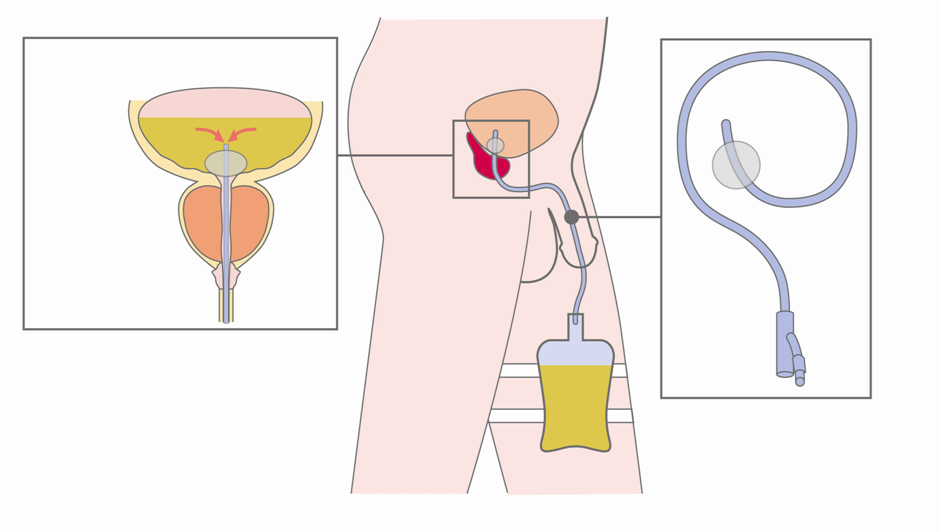Urinary Catheters
Some surgery for penile cancer will require a urinary catheter to be inserted into your bladder. This may need to stay in for several days. A urinary catheter is a plastic tube that drains urine from the bladder and is connected to a leg drainage bag. A bigger bag can be attached to the leg bag for drainage at night.

The catheter is held inside the bladder by a small balloon which is inflated with sterile water. It will not come out unless the balloon is fully deflated. The balloon tends to rest over a sensitive area of nerves in the bladder which can make you feel that you need to pass urine urgently (catheter spasm). Sometimes a small amount of urine will pass around the catheter when this happens. Using a strap or tape to fix the tube of the catheter to the thigh or top of the leg to prevent it from pulling or dragging may help (unless lymphoedema is present). If lymphoedema is present, you should avoid using tight straps or tape.
Catheter Care
- The catheter should not be pulled.
- It is very important to drink 2 – 3 litres of water-based fluid daily. This will help to flush the urine through the catheter and reduce the risk of urinary infection.
- The catheter bag should always be kept below the bladder to prevent urine flowing backwards into the bladder which can increase the risk of infection.
- Empty the bag every 3-4 hours or when half full to prevent pulling on the catheter.
- Change the leg bag approximately every 7 days.
- Ensure you bowels open regularly to avoid constipation which could cause problems with the catheter.
- When emptying or connecting catheter bags, you should always wash your hands thoroughly before and after with soap and water.
- Painkillers such as paracetamol and ibuprofen may help ease discomfort caused by the catheter.
In some cases it may be possible to use a catheter flip flo valve. This is a valve similar to the one found on the bottom of a catheter bag which can be connected directly to the end of the catheter tube. This means that providing the valve is released on a regular basis (for instance every 2 hours) to allow urinary drainage, a leg bag is not needed, although a drainage bag can still be connected. This is not suitable for everyone and you should check with your nursing or medical team whether it is safe to use a flip flo valve.
Catheter Removal
The catheter will be removed by deflating the balloon. Sometimes it can take some time for your bladder to work normally again, and you may find it difficult to control the flow of urine. This will usually improve quickly. It can be helpful to reduce your intake of carbonated (fizzy) drinks and drinks which contain caffeine for a few days, as these can stimulate the bladder and may make you urinate more frequently.

After the op I was told to change the leg bag after 7 days and how to connect the night bag. When I got home had trouble with the tube tugging. My lass works in health care and got me a strap which held the tube still against my leg and stopped the bag from tugging the tube every time I moved. It reduced the discomfort. While I had the catheter I found that morning glory was more than just in the morning and hurt as the tube slid, at the time was to embarrassed to ask what might help. Since then I’ve found out this is common.

Reviewed November 2023.
